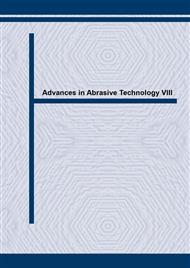p.377
p.381
p.385
p.389
p.395
p.401
p.407
p.413
p.419
Corrosion Inhibiting Effect on Copper Chemical Mechanical Planarization (CMP) in Fe(NO3)3 Based Slurries
Abstract:
The slurry of Copper chemical mechanical planarization for ultra large-scale integrate circuit (ULSI) usually contains oxidizer, etchant, complexing reagent and corrosive inhibitor. In planarization process, the corrosive inhibitor has an important effect on the planarization. Only if the concave surface of the wafer is properly protected from corrosion by the inhibitor, the process can obtain perfect surface planarity. In this paper, with Fe(NO3)3 as an oxidant and several corrosive inhibitors selected, the corrosive efficiency of slurries are investigated. The static etching rate and the polishing material removal rate of wafer are obtained. The electrochemical behavior of the slurry is investigated by the potentiodynamic polarization studies. And the inhibitive efficiency of the related corrosive inhibitors is calculated from the polarization data. X-ray diffraction is applied to analyze the composition modification of the copper surface. Atom force microscopy is applied to measure the surface topography of corrosive copper wafer and the value of surface roughness is measured by ZYGO surface analysis system. The result shows that the benzotriazole (BTA) is a perfect corrosive inhibitor. With addition of 0.1wt% BTA into 1.5wt% Fe(NO3)3 solution, the inhibitive efficiency can reach 99.1%. The polishing test shows that if only 1.5wt% Fe(NO3)3 is added as an oxidizer without any other additive, the surface roughness of the polished wafer is 26.9Å, while with 0.1wt%BTA added in the meantime, 5.2 Å of surface roughness can be obtained.
Info:
Periodical:
Pages:
395-400
Citation:
Online since:
August 2005
Authors:
Price:
Сopyright:
© 2005 Trans Tech Publications Ltd. All Rights Reserved
Share:
Citation:


